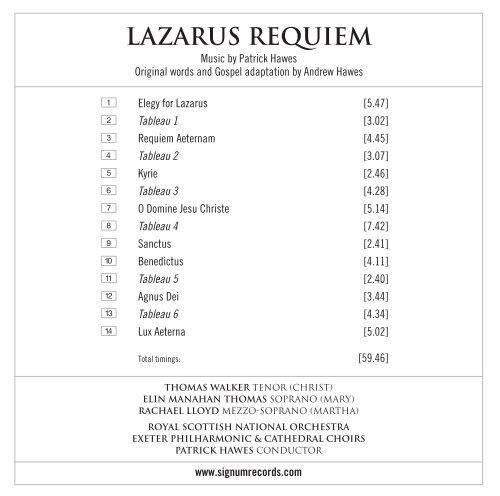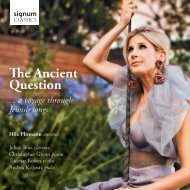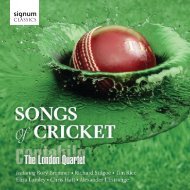Create successful ePaper yourself
Turn your PDF publications into a flip-book with our unique Google optimized e-Paper software.
LAZARUS REQUIEM<br />
Music by Patrick Hawes<br />
Original words and Gospel adaptation by Andrew Hawes<br />
1 Elegy for <strong>Lazarus</strong> [5.47]<br />
2 Tableau 1 [3.02]<br />
3 <strong>Requiem</strong> Aeternam [4.45]<br />
4 Tableau 2 [3.07]<br />
5 Kyrie [2.46]<br />
6 Tableau 3 [4.28]<br />
7 O Domine Jesu Christe [5.14]<br />
8 Tableau 4 [7.42]<br />
9 Sanctus [2.41]<br />
0 Benedictus [4.11]<br />
q Tableau 5 [2.40]<br />
w Agnus Dei [3.44]<br />
e Tableau 6 [4.34]<br />
r Lux Aeterna [5.02]<br />
Total timings: [59.46]<br />
THOMAS WALKER TENOR (CHRIST)<br />
ELIN MANAHAN THOMAS SOPRANO (MARY)<br />
RACHAEL LLOYD MEZZO-SOPRANO (MARTHA)<br />
ROYAL SCOTTISH NATIONAL ORCHESTRA<br />
EXETER PHILHARMONIC & CATHEDRAL CHOIRS<br />
PATRICK HAWES CONDUCTOR<br />
www.signumrecords.com<br />
<strong>Lazarus</strong> <strong>Requiem</strong><br />
For centuries, the requiem mass has been the<br />
most eloquent and intense means of prayer for<br />
the departed. The offering of the sacrifice of the<br />
Eucharist as a means of intercession has been<br />
the inspiration for the most sublime music. In<br />
the mass, earthly grief is assumed in the worship<br />
of heaven. In the sign of the raising of <strong>Lazarus</strong><br />
in the eleventh chapter of St. John’s Gospel, Jesus<br />
is seen encountering the raw and angry grief<br />
of Martha and Mary, and is moved to tears at<br />
<strong>Lazarus</strong>’s grave. Jesus, who declares himself<br />
‘The Resurrection and the Life’, is both the<br />
victim of death’s pain and a victor over its<br />
power to separate and diminish humanity. In<br />
all this, he prefigures the events of Easter. In<br />
the <strong>Lazarus</strong> <strong>Requiem</strong>, the mystery of life and<br />
death, the pain of grief and the hope of a risen life<br />
are held in taut symmetry. The experience of<br />
death and dying, the challenge of faith and<br />
the promise of hope are all present. These are<br />
words and music for any person who has wondered<br />
in the face of death.<br />
There are many variations of the Propers for<br />
a requiem, and composers have used various<br />
configurations to serve their own creative ends.<br />
The text of the <strong>Lazarus</strong> <strong>Requiem</strong> follows that used<br />
- 3 -<br />
by Fauré very closely – except at the very end<br />
where the traditional reference to Dives and<br />
<strong>Lazarus</strong> has been omitted (as this refers to a<br />
different <strong>Lazarus</strong>.) Fauré’s <strong>Requiem</strong> selects all<br />
the texts that point to heaven and the hope of<br />
the resurrection. In the same way, the <strong>Lazarus</strong><br />
<strong>Requiem</strong> emphasises the victory of Christ over<br />
death, but does not evade the pain and confusion<br />
that death leaves in its wake. The eleventh<br />
chapter of St. John’s Gospel figures heavily in<br />
the funeral rites of the reformed tradition,<br />
stressing the need for the personal recognition<br />
of Jesus as ‘the resurrection and the life’. In this<br />
way, the <strong>Lazarus</strong> <strong>Requiem</strong> opens up a truly catholic<br />
perspective on the Christian experience of death<br />
and dying.<br />
There are various examples of the liturgical<br />
sequence of the requiem being used as a<br />
framework to carry other texts: Britten’s War<br />
<strong>Requiem</strong> is one English example. In the <strong>Lazarus</strong><br />
<strong>Requiem</strong> the text, with the exception of one<br />
original poem, is from the New Testament. In<br />
this way, the liturgical text and the scripture<br />
throw light upon one another and so illuminate<br />
the hearts and minds of all those who perform<br />
and listen in a ‘double light’. It is possible<br />
both to extract the Latin texts and use them as<br />
a liturgical setting, or to extract the narrative of







